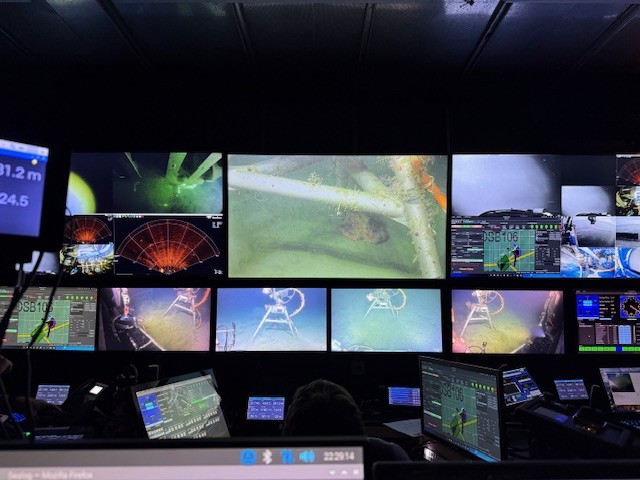
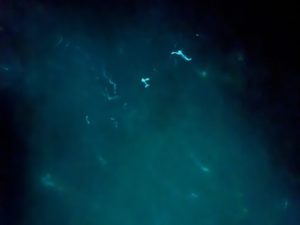
August 27, 2025
The morning watch today mainly consisted of doing one activity which was replacing the ethanol in the scale worm tubes with Andrew and Oliver. I didn’t know until now that this was actually needed to keep them preserved. This took us until around 3 am with a few breaks in between. One of the breaks consisted of looking at the bioluminescence near the ship’s stern. I’ve only ever seen this on Bainbridge Island in Washington, but this was a lot better than that. Because there had been no moonlight, it was a lot more vibrant. I saw a few lumps that were bright, but I didn’t know if they were jellyfish or plankton clumped together. Andrew was the one who suggested the plankton theory. I also took a photo, and I’m surprised that it actually came out well becauseI haven’t been able to take pictures of the bioluminescence in the past. I stayed out there staring at the same spot for around 10-20 minutes. When I got back, the night ended with Andrew, and I cleaned up the wet lab.
After I woke up, there was no dive going on, so I was able to eat lunch without rushing. I then sat around in the Main Lab until we had a meeting with Captain Derek. This meeting was extremely fascinating as I was thinking of being a captain in high school until I wanted to focus more on research. I didn’t realize how much it entailed to be one until he explained the amount of schooling one had to do, as well as experience needed. He also told us that he was out at sea for six months of the year, which made me realize that I wouldn’t want to be out at sea for that long at once. Also, I wonder what the experience was like to be going across really high and rough waves in the Arctic Ocean because he’s done it before.
Once the meeting ended, I realized that there was a dive going on, which meant that I had to head over to the Jason van. This dive consisted of replacing a digital still camera (CAMDS), which was taking photos of fish on the seafloor. During the past few days, we’ve been transiting back and forth non-stop between Slope base, Oregon Ofshore and Southern Hydrate Ridge. In all honesty, I didn’t know where this one took place, and I forgot to ask. When we reached the bottom, I was awed by how many fish there were at this site. They were mainly circling Jason and likely due to the light that the ROV emitted. I also saw a giant Pacific octopus that was resting under the CAMDS, which I got a few photos of.
When my watch ended, I ate dinner and went straight to my cabin so I could watch a new episode of a show I’ve been watching. This show has been coming out weekly for the past month and this episode was released today so I’ve been looking forward to it. I tried to watch it last night, but my internet usage had been exceeded during the middle of the episode, so I was essentially left on a cliffhanger. Because of this, I was waiting until 5 pm PST for the entire day to watch this episode. I probably could’ve asked Ella or Allison to give me an internet extension, but I felt bad doing so. I didn’t even use it up much from yesterday, so I assume that different software might’ve been updating on my phone when it wasn’t in use. Next time I’ll probably just log out of the internet whenever I’m not using my phone. Now, I’m just waiting for my next watch in the early morning, and we are transiting again so I’m assuming that there will be a dive soon.
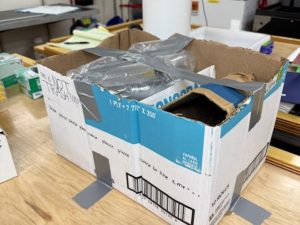
August 26, 2025
The morning watch today started off as a busy one because we just collected samples from the Jason dive earlier today where I got to pilot. This included clams, rocks with many small organisms, and a Neptunea snail. The most interesting part about the sampling was that we were also recover the snail’s egg case, which have not been well studied. The egg case was in the shape of a tower that looked like an elongated pineapple due to the wedges that ran along the sides. The snail builds the egg case upwards by sitting on the top of it. I’m very surprised that the case didn’t break when we were bringing it back up. We chose to just leave the egg case in a bucket full of seawater that went in the cold room. The wet lab was full f people doing different tasks, which made it hectic and fun at the same time.
After the sampling that occurred in the lab, sat around in the Main Lab for the most part, where I finished writing yesterday’s blog. I also had enough time to finish a video game on my Nintendo Switch. I decided to check on people that were awake, when I found both Leo and Ada trying to package part of a hydrothermal vent chimney. The deposits were very fragile and crumbled to the touch, so a lot of cushioning with bubble wrap, tissue paper, and lab cloths. The finished product looked very messy, but it was practical so I’m hoping that the piece stays intact during its journey back to Washington.
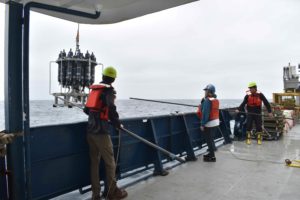
Earlier today, once I woke up, I got to work on both the deployment and retrieval of the CTD’s. I understand the deployment process the same way that I did with the retrieval, which is by interacting. I found myself having fun both times, but I liked the retrieval more because I was able to use the winch. Also, hooking the line onto one of the CTD’s outlier poles was a very satisfying part of it. For the deployment though, it felt nice to actually use knots that I learned when I was sailing for a while. I helped sample the water from the CTD for different tests, including salinity, oxygen, etc. I didn’t seem to get as wet as I thought I would either.
Another event today was the Woods Hole merch that was being sold in the Main Lab. I always buy merch from somewhere whenever I get the chance, so it was exciting to hear about this. It was also nice to see that the prices weren’t too expensive, unlike concerts. I chose to buy both a hoodie and a shirt, which only added up to $65. Also, I’m honestly surprised by how comfortable the hoodie actually is, so I’ll probably be wearing it frequently.
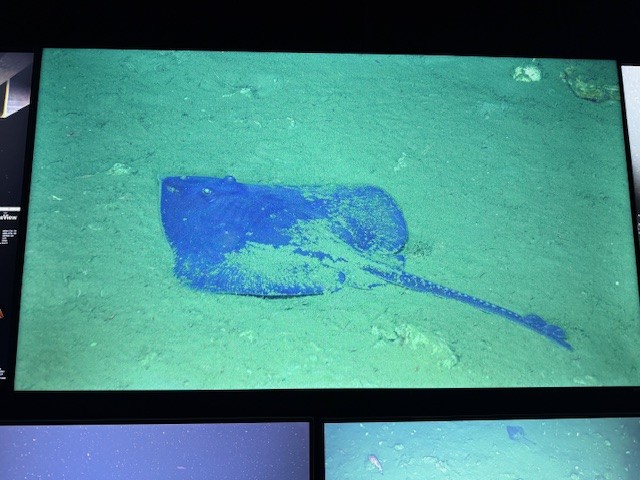
August 25, 2025
Today, I actually was able to go to sleep a little earlier than usual since there was no dive happening. My late watch consisted of playing on my Nintendo Switch and finishing my cup for the CTD launch. It felt nice to finally go to bed somewhat earlier, which made me realize that it was the second time my sleep schedule overlapped with my roommate, Nathan’s. However, I didn’t sleep that well last night from how hot it was in my room. I kept waking up in the middle of the night and even tried changing the thermostat ,but that didn’t work. Of course, when I finally got more sleep, it didn’t go well.
In the morning, I saw that there was no dive going on and that the CTD just got deployed, which meant that I had time to eat lunch. It felt good to eat without needing to rush back to my watch because I mostly just sat around in the Main Lab after that. After I ate, the CTD was being brought up and this time, I was sent out to help retrieve it. Jolee did an amazing job on walking me through the steps except I always get confused whenever I’m learning something verbally. It made sense then that I was able to understand what was going on when I physically interacted with the retrieval. It was a lot easier than I thought and even somewhat fun.
This was the CTD launch that brought down the Styrofoam cups, so I was finally able to see it after it went through the pressure of the deep ocean (9500 ft). Mine turned out a lot smaller than I thought it would be and even in the shape of a triangle. I found out later that I could’ve used paper towels inside to keep their form, but I liked the way mine turned out. It was essentially small enough to be used as a shot glass, not that I ever would. I also noticed that the cups with ridges seemed to get smaller and more deformed than the smooth cups. I’m actually still surprised that my cup is still able to stay upright on its own.
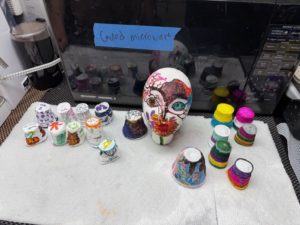
The most exciting part of the day was after dinner when I went to the Jason van. This was when we were surveying Southern Hydrate Ridge a methane seep site. This area’s seafloor had a lot more sediment/muddier, far different from Axial Seamount’s terrain. I also noticed a higher frequency of multiple organisms that were scattered everywhere on the seafloor. I learned that a lot of their diets seemed to mainly consist of detritus. What made this dive the most memorable though was the part where I was able to pilot Jason. This was such an unexpected moment ,but the main reason I was able to sit in the pilot’s seat was due to the flatter surface that made it more difficult to crash into something. I was very nervous at first, but the controls became pretty easy to understand after a few moments. I never wanted this moment to stop and I’m very grateful that I was able to have it.
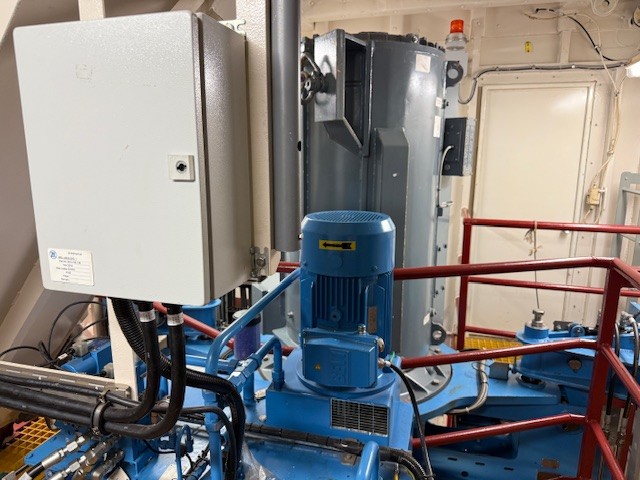
August 24, 2025
For today’s morning shift, I mainly just sat around in the Main Lab and didn’t do much. During this time, I was writing my blog last night and just playing on my Nintendo Switch. Apparently, I could’ve gone to sleep early, but I honestly like being up during the early hours of the day when only a few others are awake. Again, it was pretty peaceful, and I also learned new knots to tie. I was also a lot more rejuvenated from the nap which unfortunately kept me up past 4 am so I couldn’t fall asleep for a while.
When I woke up in the morning, it was too late to go to lunch. Honestly, I didn’t really care about lunch once I got into the van and noticed where we were at. In this dive, we were around the Castle hydrothermal vent, which was the best vent I’ve seen on this trip. It actually did look like a castle that was sitting on top of a tall, skinny part of the vent. I loved the structure of it and the number of pillars there were. We also saw basaltic arches and a few different fish every now and then, such as the Blob Sculpin. Jason started ascending an hour into my watch, which left me a little sad how soon we had to leave the site, but at least I did get to see some of it.
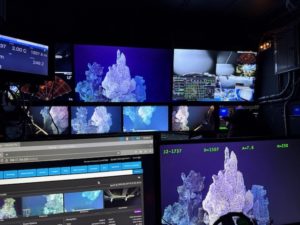
While we were ascending, I was offered a tour of the engine room with the other students. It was fascinating to see all of it, and I didn’t realize how big it actually was. It always amazes me how intricate the machinery is and how it has to all work together to keep the ship running efficiently. If I’m being honest though, I was confused by most of what the engineer was saying, but it made more sense towards the end as was answering my questions. I was also able to see what loud noises kept me awake at night sometimes, which was the bow thruster. It was extremely loud in the engine room which makes me wonder whether the engineers have lost some of their hearing over time.
After the tour of the engine room, I came back to the Main Lab where I drew on my cup that would be put in the water tomorrow with the CTD down to 2900 m. I noticed that I chose the ridged cups instead of the flat cups, which made the drawing process a little more complicated. I heard that some of the cups will shrink differently due to the different types of Styrofoam so that’ll be interesting to see. It was so cool to look at everyone else’s cups and see how much effort they put into theirs. Today also included another scale worm sampling, where I volunteered for the labeling duty since I was familiar with it. Also, ethanol has already been placed in all of the test tubes. I did have to leave halfway through due to stomach cramps that I suddenly got, but it was all just gas. I’m very glad that it wasn’t food poisoning. I mostly just spent the rest of the night in the main lab where I finished my cup and relaxed.
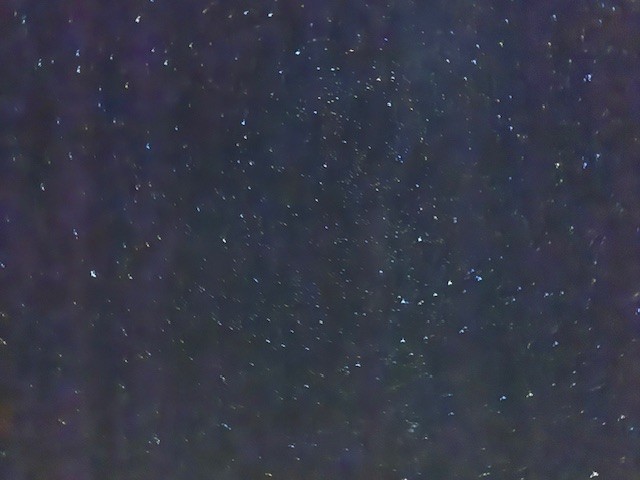
August 23, 2025
There wasn’t too much that happened today compared to the previous days. I’m even looking through my photos and realized that the only ones I took were either from inside the Jason van or random screenshots. The midnight watch started off with Jason being retrieved so it mainly involved looking at water for about an hour. During the ascent though, there was a large red squid that swam past the camera. I’ve never actually seen a squid that large before apart from photos. Once the dive ended, I just sat around in the Main Lab until the next dive started. I was about to help Mitch clean the RAS tubing, but that was right when I had to go back to the van. Since I only had an hour of my watch, I mostly just saw water again as it was descending.
That night was probably the most exhaustion I have felt during this time, so I was able to immediately fall asleep when I got back to my berthing at 4 am. I did forget to log out from the internet in the van though, but I was too tired to go back. Besides, I would be on watch immediately when I woke up so I would just be able to do it then. Even though I got around 7-8 hours of sleep, I felt extremely groggy in the morning. This might’ve been because I only got around 5 hours of sleep, and I didn’t quite make up those extra hours yesterday. It might’ve also been a good idea to drink some caffeine on my watch, but I did not have enough time after I woke up.
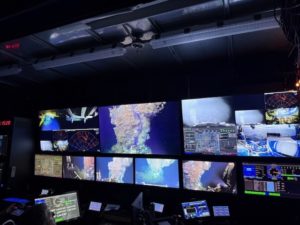
During the dive though, I got called out for the student meeting with Mike where he talked about deep-sea biology. This was amazing as I didn’t realize how many other strange animals actually lived in these ecosystems. He also explained the different projects he’s done and how they ended up going. He showed one particular animal that would go around in a perfect spiral on the seafloor and consume detritus. I do wonder how it was able to make such a perfect circle. He also showed how deep-sea exploration technology is evolving and different methods that can be utilized for exploring this region.
After the meeting, I went back to the van where we surveyed a hydrothermal vent called “Nine Meters”. I’m guessing it got the name from being around nine meters tall. I wonder if that name would change if it ever broke apart and got shorter. We also took some samples of tubeworms, palm worms, and scale worms, which are being separated on the boat right now. I didn’t realize that I stayed up for over an hour after my watch ended from how mesmerized I was by this vent.
When my watch ended, I decided to take around an hour nap as I still felt the same amount of exhaustion from this morning. However, I forgot to set an alarm, so I ended up napping for three hours. Due to this, I unfortunately skipped dinner, but I apparently made it on time for stargazing with Julie, Oliver, and Debbie. It was amazing to finally see the stars where there’s no light pollution except for the ship’s lights. I was able to see the big dipper and a few shooting stars. I tried to get a night mode picture of the stars, but you have to be steady and that tends to be a challenge on a boat that was currently being rocked around.
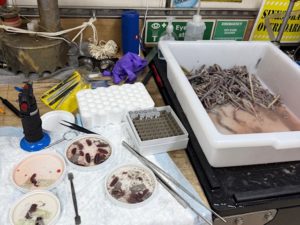
August 22, 2025
The 12-4 am shift today was very different from all the others. After Jason took samples of tubeworms and scale worms, Ada and Andrew worked to separate them. Since there wasn’t a dive happening, I helped them with this by adding labeled stickers to different test tubes and then adding ethanol. These test tubes were used for the scaleworms’ scales. We then had to tie up the scaleworms, label them, and preserve them in formalin. In this lab, I was very happy to have just had the job as a scribe. About an hour into this process, I went back up to the Jason van because a deployment was about to happen. I was only there for an hour though because it was towards the end of my watch.
After my watch, I was still wide awake and wired from drinking a lot of caffeine that night. Instead of sleeping, I decided to go back to the wet lab and help with the sampling again. This time, I was put on the duty of tying up the worms, which was a much longer process than the other stations since I had to tie square knots using very thin line. Those worms were probably the strangest things I’ve ever touched.
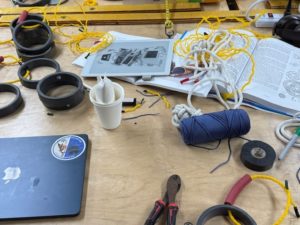
I went to bed about two hours after my watch ended, which was around 6 am. We didn’t finish, but I decided to go to bed early so I could actually get a good amount of sleep before my watch at 12 pm. Andrew and Ada didn’t go to bed until around breakfast time, but they made it up by sleeping for a good while during the day. So far, this has been the longest I’ve stayed up while on this Leg.
When I woke up in the morning, I didn’t feel as tired as I thought I would. However, it took me a while to actually wake up, so I didn’t make it to lunch before my watch. Jolee has been very nice though as she’s been taking over for me when I get into the van so I’m able to eat. Once I went back to the van, it was fairly boring since plume surveys were happening, so the view was just water for the most part. That only lasted for about an hour though as Jason was being retrieved soon after my watch started. After this, I went back to the Main Lab where I worked on rigging and did knot training for Jason. It seemed to take me a lot longer to finish than anyone else. I do hope to see mine in the water live as we put our names on the rubber hose part of the ring.
Later today, me and Nathan worked on putting PPS filters for (microbial DNA) back together and placing the components on PPS which definitely frustrated me a lot less than the rigging that occurred earlier. However, we forgot to put a band in one of the filters, which is used as a seal, so salt doesn’t crystallize inside of them. We looked through each one to see which was missing a band and it turned out that the last one we dismantled was the culprit. We got it done pretty quickly though so that was nice. I’m now just waiting in the Main Lab for my midnight watch. I really like it around this time since the boat gets very peaceful and quiet, which I very much don’t mind at times.
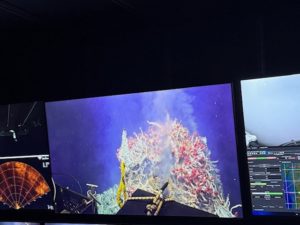
August 21, 2025
I find it funny how different the same days can be on the ship. Overall, today was a lot busier than yesterday. It started off with my watch for a 23-hour dive, which makes me wonder what’s the longest dive that Jason has done. During my shift, the dive mainly consisted of surveying multiple hydrothermal vents under Guangyu’s supervision. I’m not too sure exactly what he was doing it for so I actually might ask him that later. Some of these vents included Virgin, Hell, and Phoenix. I forgot the name of the specific vent, but there was one that looked very extravagant. I also want to note that I thought I’ve gotten used to the early morning shift but instead, I was extremely exhausted the entire time. I will probably drink some caffeine for my next morning shift.
This morning when I woke up, I slept through most of my alarms and realized that I wouldn’t make it to lunch on time before my watch. Thankfully, Andrew was able to cover for me so I could eat. When I went back to the Jason van after eating, I immediately had to leave for the student meeting. This meeting consisted of Adam discussing how he came to work with Jason. It also got me thinking about getting more experience within my field of interest and that having a bad school quarter/semester won’t completely derail career plans. He also recommended some different programs to join.

I again went back to the van for a short while because I was still on my watch, but about 15-30 minutes later, I get called out to help with R.A.S sampling (remote access fluid sampler). I didn’t realize how many people needed to be involved with this process until it actually started. There were three stations where we all collaborated together. In order, the first station weighed the sample bags, the second station took out the liquid/gas (if there was any) from the sample bag, and put them in gas tight jars. However, there were about 6-7 gas tight jars in a row that did not get a good vacuum out the sample from the syringe. It was slightly worrying as we thought the rest of the jars might be the same, but thankfully, that turned out not to be true. The third station separated the liquid into pH bottles and other vials. It took a while, but we finished just in time for dinner, which was amazing as always.
Before my night shift started, I went to the van since there was a really fascinating dive occurring. Indeed, there was! Since this ship has departed, I’ve not seen as many tubeworms around a hydrothermal vent compared to this one. To me, the whole site looked like it was just covered in Truffula trees from The Lorax. Abundant tubeworms and scale worms were sampled and brought up with Jason, so it’ll be amazing to see that later. On that note, I was thinking of having my project on deep sea creatures’ adaptation to the surface. I’m still thinking about it though because I’m not sure how far I can go with that topic.
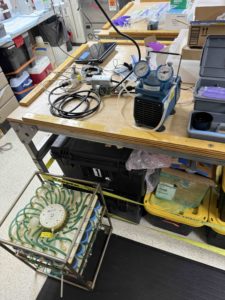
August 20, 2025
Today was one of the less busy days compared to the last few. It first started off with my 12- 4 am dive log, which ended pretty early since I started when Jason was being retrieved. This was my first time seeing this part of the dive. It was especially fun to witness it at night since there’s a bright glow in the water when the ROV nears the surface. My shift still had three hours left after that, so I spent the most part of it in the Main Lab. Occasionally, I helped Alex with a few tasks such as carrying the IGTs (gas-tight samplers for recovering dissolved gases in the vent fluids) to Jason and cleaning up the science lab. I would also like to note that I have finally gotten used to my shift schedule, which helps a lot with staying awake in the early morning hours.
It was very convenient that I went to sleep immediately after my head hit the pillow. I also want to note that my dreams have been very vivid and memorable while being on this ship. I don’t know if it is from the rockiness of the boat or just the different sleep schedule from back home. I did really want to see the “Mushroom” vent that Jason was diving towards right after my shift, but my body refused to wake up for that. On the bright side, I woke up early enough to eat lunch before my next shift, which was amazing like all the others so far.
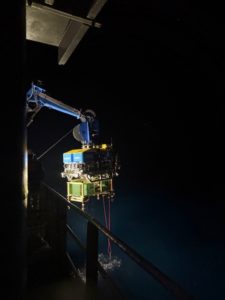
Like the last shift, I started logging when Jason was being retrieved so I ended up just staying in the Main Lab until being called for something, which did indeed happen. I got to do new and hands on which was helping Mitch collect water samples from the PPS (which filters vent fluid in situ for microbial DNA shore-based analyses). To me, I always have a good time whenever I get to do lab work. The first few filters took a while to empty out but once we got the hang of it, we went through each one in about two minutes. However, the IGT leaked out gas, so we had to evacuate during our sample collection.
During dinner and my break hours, I talked to a few people on this ship about the different opportunities I could pursue in the field of Oceanography. Coming onto this ship, I knew it would also be a good chance to have these types of conversations with professionals in this field. I learned about a program called Sea Semester and also the fact that there were a lot more scholarships within the field of marine science than I thought. I also got a lot of information about different working environments in this career. Overall, this day was pretty relaxing.

August 19, 2025
So far, all of the days on the ship have been very eventful. I first had the early morning shift from 12-4 am and even though it occurred before I went to sleep, it still happened on August 19th so this will be included in this blog. This watch involved junction boxes again, which was very similar to what I logged on my last shift. However, there were a lot of new actions going on towards the end of my shift. This time, Jason used the temperature probe and took various readings from different vents. The goal was to place a vent cap on one of these vents to help collet fluids into a remote access sampler for follow-on analyses of chemical properties on shore. There were some challenges though as the cap would only be able to sit on a vent that emitted water at 20-50 °C. Unfortunately, we weren’t able to find this temperature range of venting one so I was told that they would try again at a later time.
During my 12-4 am shift, I usually get really tired towards the end, which makes getting to sleep much easier. This time though, I became wide awake immediately after my head hit the pillow. I wasn’t able to fall asleep until about 2-3 hours after, so I only got around 5 hours of sleep. Because of this, I slept through most of my alarms except for the last one at 11:40 am, which meant that I had to skip lunch – but I made it to my shift on time. Also, I’m very surprised by how comfortable the beds are on this ship. I was expecting it to feel much like the University of Washington dorm mattress, which feels much like laying down on a flat rock.
My afternoon shift was very pleasant. I got to see Escargot again and this time, IGTs (Isobaric gas-tight samplers) were used to take samples of fluids coming out of the vent on its side I always like it when any of the scientists come in during my shift so I can ask them questions about different locations in the dive. This time it was Deb Kelley and Mike Vardaro. During my shift, I was pulled out so I could get a tour of the bridge. It was really fascinating seeing all the instruments up close. I was shocked though when I found out that the ship didn’t have a helm. Apparently, a joystick is used for manual steering.
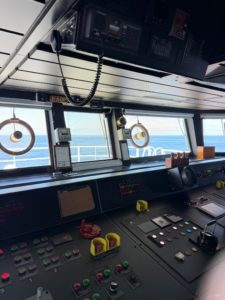
One of the biggest events from my day was when dolphins were swimming around the ship twice today. The first was during the afternoon, but they only stayed around for a few minutes. I didn’t even know that there were dolphins in the North Pacific, but it was really cool to find that out visually. The second time occurred during sunset, which made the moment perfect. They were so close that I heard the dolphins clicking. There were a lot more surrounding the ship this time and I was able to get many good photos and videos. This was definitely one of my most memorable experiences.
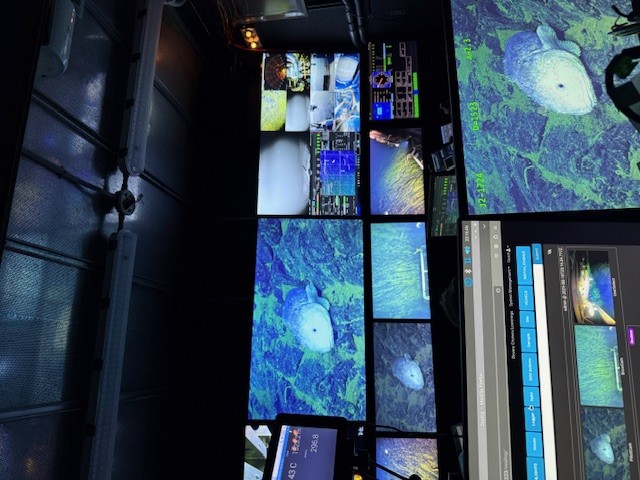
August 18, 2025
Today is the second day that we are on the sea and the queasiness has definitely let up a lot. It could also be the fact that by the time I woke up, the ship was not in transit anymore, which seemed to ease the rockiness. It was nice that I was still able to get around 7-8 hours of sleep considering the fact that I went to sleep at 4 am and woke up around 11:15 am. On the other hand, I was a bit saddened when I heard that dolphins swam by the ship while I was asleep. It was really nice to go to sleep with the rockiness and the noise coming from the bow as I find myself sleeping better in these conditions (have a very hard time trying to sleep in complete silence).
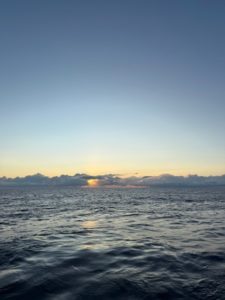
My first shift in the Jason van happened today and it was amazing. First, I note that my afternoon shift time from 12-4 pm is very convenient since I had time to eat lunch before I had to start shift. It was also nice to actually eat lunch during the designated times as I missed both lunch and dinner yesterday because I got the times mixed up. Being in the Jason van and logging various details was actually very peaceful. This might also be due to the fact that I’m not the one who has to navigate or control the ROV. I actually do wonder whether or not it’s stressful for the pilots, or if it’s just something fairly simple as they seem to do it a lot. As I stated in yesterday’s blog, I tend to learn better through interactive means which stayed true with the logs.
Witnessing the actual footage from Jason in the deep water felt extremely surreal. It was like watching a video game being played until it clicked that this footage is happening in real life and in real time. There were many different marine organisms that I saw. I’ve never even heard about most of them before this experience such as a Grenadier (rattail fish). After dinner, I even chose to go back again, and a lot of people were already there. It felt a lot like a movie theater, but in this case, for a live movie that everyone was interested in. I also learned a lot about the site, “Escargot” during this viewing. While I was on my shift, it also felt like time went a lot faster than usual. At least, it does when I’m in the van.
I do have another shift in the early morning from 12-4 am. Since I went to bed at 4 am last night and changed my sleep schedule, hopefully I don’t feel too exhausted during that period. I am very excited again to see what happens this time and it would be nice to see some new organisms again. I also haven’t mentioned that the sunset here was beautiful today. Yesterday, it was cloudy during the sunset so today was a good change of pace. The clouds were right in front of the sun as it went under the horizon so the light rays from the sun were visible. Overall, today has been another smooth, yet pretty busy day.
August 17, 2025
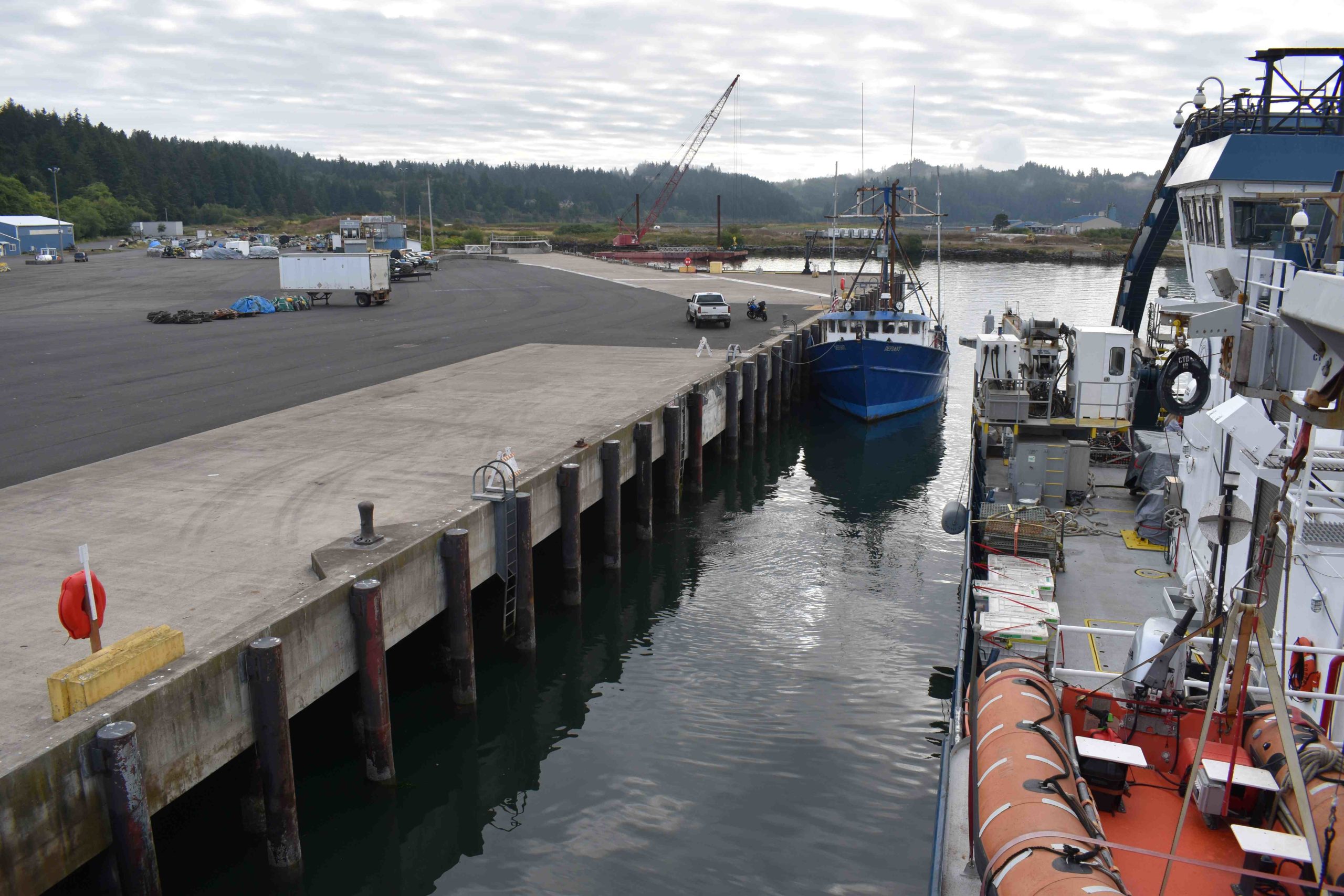
R/V Atlantis departed in the morning. It was a very smooth departure out of Newport. However, on the way out of the Newport harbor, the ship started to become a lot rockier with the larger waves that were hitting the ship. I was definitely not used to it as the only ships I’ve been on mainly consisted of the Puget Sound Ferries, which tend to be a very smooth trip since the waters aren’t too rough. I am very happy that I took sea sickness medicine the night before as I started to feel a little queasy about 1-2 hours from our departure. It probably would’ve been much worse if I had not.
Today, we had our emergency evacuation drill which involved a lot of solutions to different outcomes. For example, I didn’t even know there was ladder and a hatch in the science berthing area until we were shown during the drill. This is just in case the stairs going upwards are inaccessible during an emergency. I also learned where we go on the boat if we have to evacuate. I would’ve never thought that I would need to put on a wetsuit (immersion suit) if the ship had to be abandoned, but it would keep me warm which is the plus side. It was also kind of fun getting into a wetsuit since I’ve never put one on before.
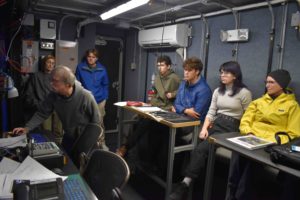
Today trended as the day of different orientations. The next meeting was about the CTD deployment and retrieval, which wasn’t too complicated. It was interesting to see how much effort actually went into this process. I didn’t know people were actually needed outside to attach lines to the CTD, so it is brought up/down without swinging around and crashing into the ship. It did seem like the actual event would be much harder than what I was shown in practice. Even though they were planning to launch the CTD tomorrow morning, I will probably be sleeping through it since Alex suggested that I should stay up until 4 am so that I can get used to my shift schedule.
There was another meeting which was about Jason. It was really cool to see all the intricate parts that made up this ROV. I didn’t realize how many cables on the outside were exposed so I do wonder if they get caught on anything. We then went into the Jason Van, which really made me feel like I was in a control room on a movie set. They explained a lot about the logging job, but I happened to be confused about much of it. Most likely, I will understand it a lot more tomorrow when I’m actually interacting with the website during deployment.
Transit has made me feel very queasy and sleepy at the same time. Well, at least I got over the queasiness, but I did one long nap since I didn’t get much sleep the night before and it already felt like the boat was rocking me to sleep. This nap also helped a lot when I had to stay up until 4 am, which I’m honestly surprised I achieved. During the night hours, I did tubing sectioning with Alex which was very repetitive but very convenient since I didn’t have to put much thought into it. Also, I do want to note that everyone on this boat has been extremely kind and caring. With that it’s definitely a factor in why I’m having a great time on this cruise already.
